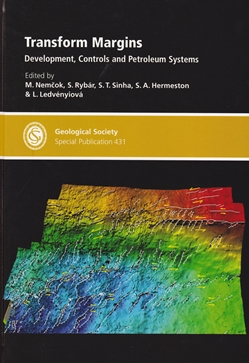 Transform margins are the Cinderellas of plate tectonics, having received far less attention than their convergent and divergent sisters. This volume, originating in a University of Utah workshop in late 2013, is a valiant attempt to redress the balance. The editors note that each presentation was followed by ‘time-unconstrained discussion’.
Transform margins are the Cinderellas of plate tectonics, having received far less attention than their convergent and divergent sisters. This volume, originating in a University of Utah workshop in late 2013, is a valiant attempt to redress the balance. The editors note that each presentation was followed by ‘time-unconstrained discussion’.
What an enviable event that must have been, and evidently successful because, unlike many conference volumes, this one hangs together as a coherent whole. Its focus is very much on the mid-Atlantic, on both its South American and Gulf of Guinea sides, but room has been found for the Caribbean (Cayman Trough), East Africa (Davie Fracture Zone), the Arctic (an invaluable overview of a relatively poorly-documented area), the Andaman Sea and (a slightly questionable inclusion) eastern India. As is now the norm with Geological Society Special Publications, each chapter is copiously and relevantly illustrated, and colour is used unstintingly. Perhaps too little consideration was given by some authors to the reproduction sizes possible in pages of the known and standard format but I suppose we can all use a magnifying glass!
The main Central Atlantic study area is, of course, much more than the site of a pair of conjugate transform margins; it is the area where the spreading regimes of the North and South Atlantic merge, overlap and interact. Free-air gravity patterns document these processes with remarkable clarity, but leave the reader with a question. Are the margins formed really typical of transform environments? The further one reads, the more that question looms. After absorbing all the papers dealing with this area (and these are meaty productions and seldom easy going), it is impossible not to wonder whether these are transform margins at all. No single fracture zone defines either and it seems that the initial break-up involved extension as much as, and probably more than, strike-slip motion.
The other areas covered repeat this pattern, and the game is given away completely by the title of the Andaman Sea paper, which focuses on ‘….evolution from an extensional to a sheared margin’. This process, it seems, is fundamental to the evolution of most and perhaps all the margins discussed. Perhaps there are no transform margins, sensu stricto, anywhere in the world and initial extension has been needed everywhere to unclog the system and allow transcurrent motion to occur. To suggest this in no way reduces the value of this volume. It can plausibly be argued that it enhances it.
TRANSFORM MARGINS: DEVELOPMENT, CONTROLS AND PETROLEUM SYSTEMS by M. NEMČOK, S. RYBÁR, S. T. SINHA, S. A. HERMESTON & L. LEDVÉNYIOVÁ (Eds.) Geological Society Special Publication 431. 2016. ISBN 978-1-521-86239-744-6 385 pp. List Price £120.00. Fellows: £60.00 www.geolsoc.org.uk/SP431